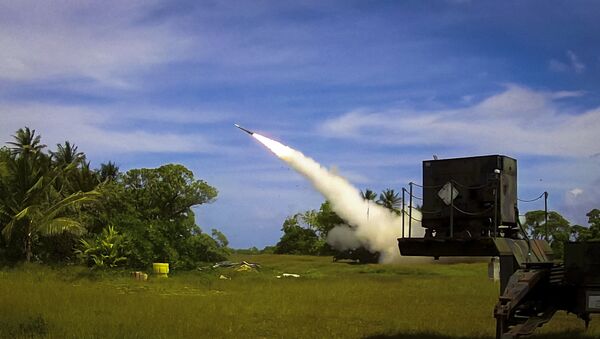When a swarm of suicide drones and cruise missiles approached the oil processing facility at Buqayq and oil field at al-Khurais in the pre-dawn hours of September 14, they came in low, avoiding Saudi air defenses and leaving soldiers on the ground with little more than small arms to repel them. The Saudis and their US allies had numerous Patriot air defense systems deployed in the area, but the batteries can’t aim below the horizon, limiting their effectiveness against small targets.
Decades ago, the US military had extensive short-range air defense systems (SHORADS), but after the end of the Cold War, the Pentagon shifted toward longer-range strategic threats. Systems like the Patriot, Ground-Based Midcourse Defense (GBMD) and Terminal High-Altitude Area Defense (THAAD) all focused on downing high-trajectory, exo-atmospheric weapons like ballistic missiles, leaving a vital tactical hole exploited by whoever carried out the Aramco attack.
To fill that gap, the Pentagon has advanced Raytheon’s Coyote loitering munition: a so-called “kamikaze drone” that can stay airborne for up to an hour and would neutralize attackers like those that hit Aramco.
“The most capable in its class, the Coyote unmanned aircraft system is small, expendable and tube-launched. It can be deployed from the ground, air or a ship,” the defense contractor’s page for the weapon says. “It’s ideal for improved surveillance imagery, enhanced targeting capability, near real-time damage assessment and reduced threat to manned aircraft.”
The Army first deployed the Coyote in June, pairing it with the KuRFS Ku-band short-range radar and redubbing the system “Howler.”
"You need detection in depth, and defense in depth, because if you face a threat like the Saudis did with the recent attack that they underwent, the further out that you can detect the threats and engage them, the less chance that you're going to suffer as much damage [with] the leakers that start coming through," John Hobday, head of business development for Coyote and Rapid Development Programs at Raytheon told Military.com.
Cliff Johnson, director of Tactical Radar business development for Raytheon Integrated Defense Systems, told Military.com the Howler will protect the Patriot batteries themselves, too.
"We'll have a Howler system to defeat any of those small [unmanned aerial vehicles] that may want to be a kamikaze type of a missile into the Patriot system itself. So that's a classic piece of how we're integrating and keeping that layered air defense and counter-UAS [unmanned aircraft system] architecture together to protect the protector," he said.
"You don't want to shoot a Patriot at a small UAV, because that's an important asset to take on a much more complex target," Hobday noted.
Indeed, in 2017 an unnamed “US ally” did just that, wasting a $3 million Patriot missile on a “quadcopter that cost 200 bucks from Amazon.com,” as US Army Gen. David Perkins, then commander of the US Army Training and Doctrine Command, put it at the time.
Back in February, the US Army went so far as to purchase two Iron Dome short-range air defense systems for $373 million. Israel uses the Iron Dome, built by Israel’s Rafael Advanced Defense Systems, to shoot down short-range rockets fired by militants in Gaza and southern Lebanon. However, Gaza-based Hamas recently boasted it had found a way to pierce the Iron Dome.



